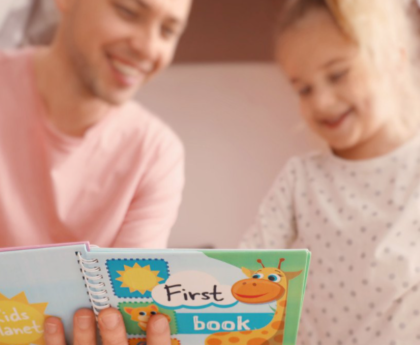If you’re reading this, you know your way around complex sentences. You likely speak, read, and communicate without considering how it all works.
As an adult, you may not recall how you learned your language skills. But as the parent of a child learning to read, it’s helpful to retrace your steps.
Complex sentences are made up of a string of words. Words are made up of smaller building blocks called phonemes.
The better you understand these building blocks, the better you’ll be able to support your early learner.
Let’s Start at the Very Beginning
The beginning stages of reading start with phonemes.
What are Phonemes?
Phonemes are individual units of sound that exist within human language. Different languages can have different sets of phonemes or share primary sounds.
The English language has approximately 44 phonemes, made possible by its 26 letters in the alphabet. Some letters make multiple sounds, depending on the context and the combination of letters.
Here are some phonemes you can sound out:
- The phoneme for “T” occurs when you engage the tip of the tongue against the roof of your mouth to create the letter’s sound (example: “turtle”).
- The phoneme for “th” is expressed when the tongue moves forward slightly between the teeth as you emit a small amount of air. This creates the phonemic sound you hear at the beginning of “thanks” and “Thursday”.
- The letter “E” has multiple phonemes: the sounds of “ee” or “eh”, and in rare cases, “ah” (such as in more advanced words like “genre”).
Sounds in Early Language Development
Many children gain early literacy skills through conversation and songs. Talking, playing, and singing with your children are great precursors to phonemic awareness.
By the time your child is ready to learn to read, they will recognize the “mmm” sound you make, encouraging an awareness that words like “mat” and “mad” have the /m/ phoneme in common.
What is Phonemic Awareness?
Phonemic awareness is the understanding that words are comprised of different sounds.
It creates the ability to segment and then blend distinct sounds, which enables humans to speak and read words.
Phonemic Awareness vs. Phonics
Sometimes, the terms phonics and phonemics are used interchangeably. However, they are different. They don’t describe the same skills.
- Phonemic awareness is purely auditory.
- Phonics connects the auditory component (phonemes) to the visual component of written words (graphemes).
We know there are a lot of terms going on here — if you’d like to skip ahead and start practicing, download the Reading.com app now!
Step One: Segmenting
Early readers gain a superpower when they learn to segment phonemes.
Here’s an example:
“Hat” is made up of three different sounds or phonemes: /h/, /a/, and /t/.
Keep in mind that the number of phonemes in a word isn’t always equal to the number of letters.
“Boat,” for example, has three phonemes and four letters. The phonemes in the word “boat” are: /b/, /oa/, and /t/
/oa/ is one phoneme because the two letters make one sound.
Without an understanding of the letters or combinations of letters that spell certain phonemes, a child may try to read a word like “boat” by verbalizing the sound of each letter: b — o — a — t. They might run into confusion when they don’t know what a beeoh aytee is!
Step Two: Blending
Putting phonemes together is called blending: a required skill when learning to read.
One way to encourage phonemic awareness in your child is to help them blend sounds aloud. Ask them to say words slowly without separating the sounds. This will help them hear and decipher the different phonemes.
For the word “sad,” you wouldn’t have them say /s/, /a/, /d/, separately.
Instead, you would slow down the word while blending, saying: “sssaad.”
When kids drill the ABCs without developing phonemic awareness, they tend to struggle with blending. Knowing a letter’s name is insufficient because it doesn’t help with reading. To read, children need to know the different sounds each letter represents. With practice, phonemic awareness becomes more natural when reading, and children can make better sense of words.
The best way to avoid choppiness (and frustration) when helping your child learn to read is to teach blending from the beginning.
How to Teach Blending
Here are some tips to teach blending and phonics to your child:
- Display proper blending skills: We love read-alouds and hope you do too. Eager readers will often mimic how you read to them. Instead of sounding out each letter of a word individually, show them how to say it slowly and to listen to each sound.
- Play word games: Word games help early readers identify different sounds at the beginning and end of words. They also help children practice rhyming, matching sounds in words, and blending different sounds, building phonemic awareness.
- Sing the word: If your little one struggles to blend sounds, have them sing the word instead. When they sound out the word in song form, it may be easier for them to blend the sounds smoothly.
- Stop bad habits before they start: If your child starts to sound out the word by pausing after each sound, gently stop them and model how to do it properly.
How Phonemic Awareness Leads to Strong Readers
Phonemic awareness is one of the five pillars of reading:
- Phonemic awareness
- Phonics
- Fluency
- Vocabulary
- Comprehension
When readers can segment the individual sounds in each word and then blend those sounds, it unlocks the ability to read unfamiliar words.
Phonemic awareness is the foundational skill of language. It’s also the foundation of reading, as the other four pillars build upon it.
Build Phonemic Awareness with Reading.com
Phonemic awareness is a crucial starting point on your child’s reading journey.
The Reading.com app is an effective way to go through that journey together.
Our approach is based on the proven Direct Instruction method and is thoughtfully designed to support your child’s growth as a reader.
In just 15-20 minutes a day, you can watch your child go from building pre-reading skills to successfully reading books they love.
Start your free trial with Reading.com today!





